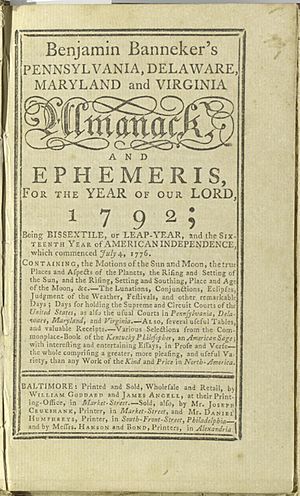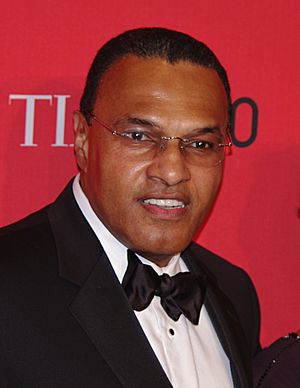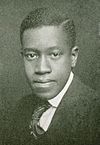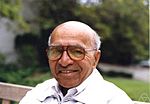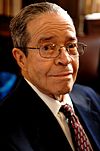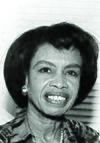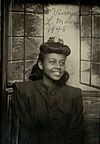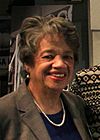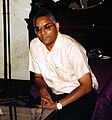List of African-American mathematicians facts for kids
The book and film Hidden Figures told the amazing story of African-American women mathematicians. These women played a huge part in the space race, even though they faced many challenges. They had to work hard to study and have careers in math and science.
Many other achievements by African Americans in math and science have also been "hidden." But the community of mathematicians has been growing! Between 2000 and 2015, about 4-6% of math and statistics graduates in the US were African American. This article shares important moments and people in the history of African Americans in mathematics.
Contents
Key Moments in History
1792: Benjamin Banneker was a self-taught scientist. He figured out how planets move and predicted eclipses in his Almanac.
1867: Howard University started its Department of Mathematics. This was a big step for education.
1895: Joseph Carter Corbin, who was president of Branch Normal College (now University of Arkansas at Pine Bluff), published his first math problem. It appeared in a magazine called American Mathematical Monthly.
1916: Dudley Weldon Woodard became a founding member of the Mathematical Association of America (MAA). This is an important group for mathematicians.
1925: Elbert Frank Cox was the first African American to earn a PhD in mathematics. He received his degree from Cornell University.
1929: Dudley Weldon Woodard was the first African American mathematician known to publish in a math journal. His article was about a math topic called "analysis situs."
1943: Euphemia Lofton Haynes became the first African American woman to earn a PhD in mathematics.
1951: The MAA decided that their meetings and events would be open to everyone, "without discrimination as to race, creed, or color." This was an important step towards equality.
1956: Gloria Ford Gilmer is thought to be the first African American woman to publish math research. She co-wrote articles in two different math journals.
1969: 17 African American mathematicians met and created the National Association of Mathematicians. Their goal was to "promote excellence in the mathematical sciences" and help underrepresented minorities in math.
1973: Mathematician David Blackwell was the first African American in any field to be chosen for the National Academy of Sciences. This is a very high honor.
1976: Howard University started the first PhD program in mathematics at a historically black college or university. This was led by department chair James Donaldson and professor J. Ernest Wilkins Jr..
1980: The Claytor Lecture was created at the MAA. It's now called the Claytor-Woodard Lecture, honoring William W S Claytor and Dudley Weldon Woodard.
1982: Civil rights leader Bob Moses used a special award to start the Algebra Project. This program helps high school students learn math across the country.
1988: The MAA created a group that led to the SUMMA program in 1990. SUMMA stands for Strengthening of Underrepresented Minority Mathematics Achievement.

1992: Mathematician Freeman Hrabowski became President of the University of Maryland.
1994: The Blackwell Lecture was created for MAA meetings. It honors David Blackwell. Other lectures, the Wilkins Lecture and Bharucha-Reid Lecture, were also established by NAM.
1995: The first CAARMS (Conference for African American Researchers in Mathematical Sciences) was held. This conference helps highlight the work of researchers and students and encourages careers in math for underrepresented groups.
1997: Kathleen Adebola Okikiolu was the first African American to receive a Sloan Research Fellowship and a Presidential Early Career Award for Scientists and Engineers. These are very important awards for young scientists.
1997: Scott W. Williams launched the "Mathematicians of the African Diaspora" website. This website collects information about African American mathematicians and resources. By 2007, it had almost 5 million visitors! The Library of Congress even cataloged it.
1999: A study showed that out of over 900 math professors at the top 25 universities in the US, only 4 were African American. This highlights the need for more diversity.
2003: Clarence F. Stephens was the first African American to receive the MAA's highest award for Distinguished Service to Mathematics.
2004: The Association for Women in Mathematics (AWM) and MAA created the Etta Zuber Falconer Lecture.
2015: Katherine Coleman Johnson received the Presidential Medal of Freedom. This is one of the highest civilian awards in the United States.
2016: The book Hidden Figures by Margot Lee Shetterley was published. It became a bestseller and won many awards. It tells the story of African American women mathematicians at NASA during the space race.
2017: The film Hidden Figures was nominated for Best Picture at the Academy Awards. Katherine Johnson even made an appearance at the ceremony.
2020: The updated "Mathematicians of the African Diaspora" website launched in October. It is supported by the National Association of Mathematicians (NAM).
First African Americans to Earn Doctoral Degrees in Mathematics
Many African American men and women have earned doctoral degrees (like a PhD) in mathematics. These degrees show a very high level of education and research in the field. Here are some of the very first to achieve this, listed in order of when they earned their degree.
Books About African American Mathematicians
There are many books that tell the stories of African American mathematicians. Some are written especially for young people, making these inspiring stories easy to read and learn from.
For Young People
- Becker, Helaine; Phumiruk, Dow (2018). Counting on Katherine: How Katherine Johnson Saved Apollo 13. This book tells the story of Katherine Johnson and her work at NASA.
- Pinkney, Andrea Davis (1998). Dear Benjamin Banneker. This book is about the life of Benjamin Banneker, an early African American scientist.
- Schwartz, Heather E (2017). NASA Mathematician Katherine Johnson. Another book focusing on the amazing career of Katherine Johnson.
- Shetterly, Margot Lee; Conkling, Winifred; Freeman, Laura (2018). Hidden Figures: The True Story of Four Black Women and the Space Race. This is a version of the famous Hidden Figures book, adapted for younger readers.
People to Learn About
This list includes Wikipedia articles about people of African descent who have degrees in math or statistics, worked in math, or are known for their math achievements in the United States. They are grouped by when they started their work in mathematics.
Before 1900
- Thomas Fuller (1710–1782): Known for his incredible mental math skills.
- Benjamin Banneker (1731–1806): A self-taught astronomer and mathematician.
- Charles Reason (1818–1893): One of the first African American college professors.
- Kelly Miller (1863–1939): Earned degrees from Howard University.
1900s
- Dudley Weldon Woodard (1881–1965): Earned a PhD from the University of Pennsylvania.
1910s
- Elbert Frank Cox (1895–1969): The first African American to earn a PhD in mathematics.
- Euphemia Haynes (1890–1980): The first African American woman to earn a PhD in mathematics.
1920s
- Joseph J. Dennis (1905–1977): Earned a PhD from Northwestern University.
- Angie Turner King (1905–2004): Earned a PhD in mathematics education from the University of Pittsburgh.
- Georgia Caldwell Smith (1909–1961): Earned a PhD from the University of Pittsburgh.
- Dorothy Vaughan (1910–2008): A human computer at NASA, featured in Hidden Figures.
1930s
- David Blackwell (1919–2010): A brilliant mathematician and the first African American in the National Academy of Sciences.
- Marjorie Lee Browne (1914–1979): Earned a PhD from the University of Michigan.
- Katherine Johnson (1918–2020): A NASA mathematician, also featured in Hidden Figures.
- Clarence F. Stephens (1917–2018): Known for his distinguished service to mathematics.
1940s
- Albert Turner Bharucha-Reid (1927–1985): Known for his work in probability theory.
- Gloria Ford Gilmer: Believed to be the first African American woman to publish mathematical research.
- Evelyn Boyd Granville (born 1924): One of the first African American women to earn a PhD in mathematics.
- Mary Winston Jackson (1921–2005): A NASA mathematician and engineer, featured in Hidden Figures.
- Eleanor Green Dawley Jones (1929-2021): Earned a PhD from Syracuse University.
- Abdulalim A. Shabazz (1927–2014): Earned a PhD from Cornell University.
- Louise Nixon Sutton (1925–2006): Earned a PhD in education from New York University.
- J. Ernest Wilkins, Jr. (1923–2011): A child prodigy who earned a PhD from the University of Chicago at a young age.
1950s
- Geraldine Claudette Darden (born 1936): Earned a PhD from Syracuse University.
- M. Lovenia DeConge-Watson (born 1933): Earned a PhD from St. Louis University.
- Annie Easley (1933–2011): A computer scientist and mathematician at NASA.
- Etta Zuber Falconer (1933–2002): Earned a PhD from Emory University.
- William Thomas Fletcher: Earned a PhD from the University of Idaho.
- Gloria Conyers Hewitt (born 1935): Earned a PhD from the University of Washington.
- Vivienne Malone-Mayes (1932–1995): Earned a PhD from the University of Texas.
- Melba Roy Mouton (1929–1990): A mathematician and computer programmer at NASA.
- Dolores Margaret Richard Spikes (1936–2015): Earned a PhD from the University of Illinois.
- Thyrsa Frazier Svager (1930–1999): Earned a PhD from Ohio State University.
- Argelia Velez-Rodriguez (born 1936 in Cuba): Earned a PhD from the University of Havana.
- Grace Alele Williams (1932–2022): The first Nigerian woman to earn a PhD in mathematics education.
1960s
- Sylvia D. Trimble Bozeman (born 1947): Earned a PhD from Emory University.
- Christine Darden (born 1942): A NASA mathematician and aerospace engineer.
- James A. Donaldson (1941–2019): Earned a PhD from the University of Illinois at Urbana-Champaign.
- Fern Y. Hunt (born 1948): Earned a PhD from New York University.
- Jeanette Scissum: A NASA mathematician.
- Raymond L. Johnson (born 1943): Earned a PhD from Rice University.
- Ronald Elbert Mickens (born 1943): Earned a PhD in physics from Vanderbilt University.
- Scott W. Williams (born 1943): Creator of the "Mathematicians of the African Diaspora" website.
- Lloyd Demetrius: Earned a PhD from the University of Chicago.
1970s
- Augustin Banyaga (born 1947 in Rwanda): Earned a PhD from the University of Geneva.
- Emery N. Brown: Earned a PhD in statistics from Harvard University.
- Freeman Alphonsa Hrabowski III (born 1950): Earned a PhD in higher education administration/statistics from the University of Illinois.
- Iris Marie Mack: Earned a PhD from Harvard University.
- Carolyn Ray Boone Mahoney (born 1946): Earned a PhD from Ohio University.
- William Alfred Massey (born 1956): Earned a PhD from Stanford University.
- Lee Stiff (1949–2021): Earned a PhD in education from North Carolina State University.
1980s
- Idris Assani (born in Niger): Earned a PhD in mathematics from Pierre and Marie Curie University.
- Melvin Currie (born 1948): Earned a PhD in mathematics from the University of Pittsburgh.
- Clifford Victor Johnson (born 1968 in the UK): Earned a PhD in mathematics and physics.
- Bob Moses (1935–2021): A civil rights leader and founder of the Algebra Project.
- Arlie Oswald Petters (born 1964 in Belize): Earned a PhD in mathematics from Massachusetts Institute of Technology.
- Suzanne L. Weekes (born in Trinidad & Tobago): Earned a PhD in mathematics and scientific computing.
1990s
- Ron Buckmire (born 1968 in Grenada): Earned a PhD in mathematics from Rensselaer Polytechnic Institute.
- Edray Goins (born 1972): Earned a PhD in mathematics from Stanford University.
- Rudy Horne (1968–2017): An applied mathematician and consultant for the movie Hidden Figures.
- Trachette Jackson (born 1972): Earned a PhD in mathematics from the University of Washington.
- Chawne Kimber (born 1971): Earned a PhD in mathematics from the University of Florida.
- Marilyn Strutchens (born 1962): Earned a PhD in mathematics education from the University of Georgia.
- Aissa Wade (born 1967 in Senegal): Earned a PhD in mathematics from University Montpellier 2, France.
- Talitha Washington (born 1974): Earned a PhD in mathematics from the University of Connecticut.
2000s
- Carla Cotwright-Williams (born 1973): Earned a PhD in mathematics from the University of Mississippi.
- Christina Eubanks-Turner: Earned a PhD in mathematics from the University of Nebraska-Lincoln.
- Omayra Ortega: Earned a PhD in mathematics from the University of Iowa.
- Candice Price: Earned a PhD in mathematics from the University of Iowa.
- Dionne Price: Earned a PhD in biostatistics from Emory University.
- Chelsea Walton (born 1983): Earned a PhD in mathematics from the University of Michigan.
- Talithia Williams: Earned a PhD in statistics from Rice University.
- Ulrica Wilson: Earned a PhD in mathematics from Emory University.
2010s
- John Urschel (born 1991 in Canada): Earned a PhD in Mathematics from the Massachusetts Institute of Technology.
Images for kids


